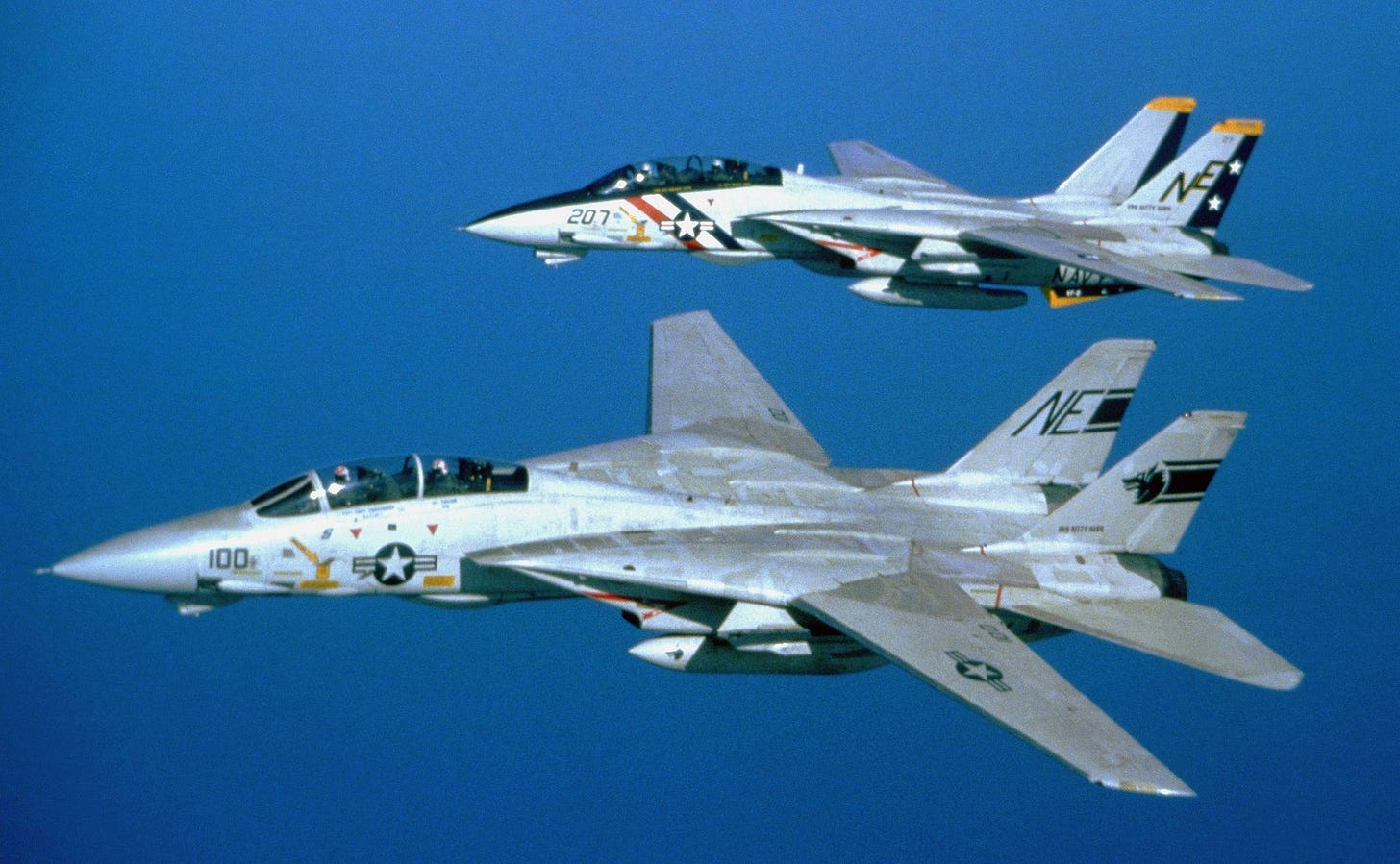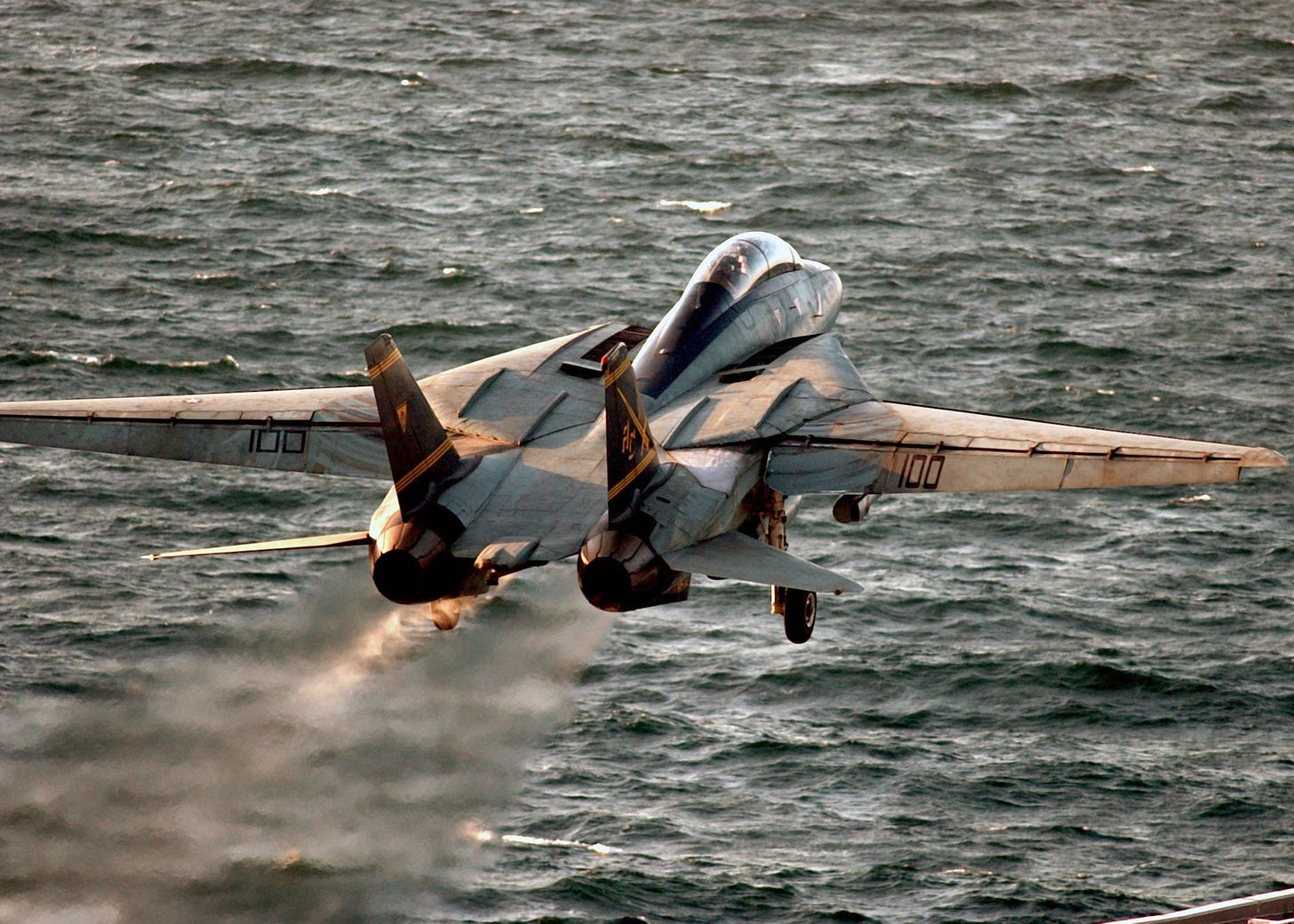33 tons of badassery, the F-14 Tomcat
Deep dive into the mad world of the world's best-looking carrier fighter
“ Something hardly ever mentioned is that to improve engine stability and longevity, maximum thrust in afterburner was actually decreased to roughly 17,000 lbs per engine. “
The F-14 Tomcat was a no-compromise carrier warplane operated by the US Navy. Bristling with the most capable weapons in the world, it was utterly formidable and rose to international fame as the star of the 1986 film Top Gun, which celebrated the Navy’s TopGun fighter school. Dave ‘Bio’ Baranek was a TopGun instructor and Radar Intercept Officer, here he describes flying and fighting in the awe-inspiring Tomcat.
What were your first impressions of the F-14?
“I’ll think back to the first time I saw an F-14 in person, at an air show in 1977, when I was in college. After reading about it in aviation magazines, I was excited. To me, it looked like a spaceship, but also a very complex form instead of just a fuselage with wings sticking out of it. When I got to NAS Miramar for training, I was surprised at (1) how big the jet was and (2) how dirty many Tomcats were, with footprints, greasy smudges, and leaking fluids. First impressions: large and complex.”
What is the best thing about the F-14?
“It had a great weapon system. Go back to the F-14’s introduction into Navy service and first deployment in 1974. It had long-range, multi-shot, look-down/shoot-down capability. I think the next American fighter to have all of these came along seventeen years later, when the AIM-120 became operational on other teen-series fighters.
I’ll add another item as the second-best thing: endurance. I’m going to throw the engines under the bus, so I might as well give them a little due credit. At throttle settings for maximum endurance, the total fuel flow was around 4,400 pounds per hour. (Of course, this would require a permissive environment, but even bumping up the speed to increase survivability still gave decent time on the station.) With the relatively large fuel capacity, this gave a healthy on-station time while maintaining a combat package. But light the burners and follow an acceleration and climb profile, and you could meet a high-fast flyer, or be at tactical airspeed in a minute or so.”
..and the worst?
“I’m going to sound like a broken record: the TF30 engines of the F-14A. Probably no surprise, and I’ll come back to this topic later.”
What was your most notable mission?
“There were actually a lot, but I’ll spotlight two of them. The first one was a training mission that was part of Project Rising Fighter, which was a series of flights on the TACTS Range near Yuma, Arizona, that was overseen by the Center for Naval Analyses. The purpose of the project was to investigate tactics against the then-new MiG-23 Flogger. To simulate the Flogger, they used full-up F-4N Phantoms operated by regular fleet squadron aircrews. There were no limits on their weapon system or manoeuvring; they were a decent approximation of a MiG-23. Meanwhile, our F-14A tomcats were armed (simulated) with AIM-7 s and AIM-9s – the same missiles as the bandits – plus our gun, of course. The set-up was a 35-mile start for a forward quarter intercept, with two Tomcats versus an unknown number of Phantoms, a 2vUNK. The bandits always presented between 4 and 6 Phantoms. The notable mission started as a 2v6, and each side lost one aircraft during the intercept. These were the days before forward-quarter tactics. So my pilot and I engaged in a 1v5, and for me it was a fantastic experience of the F-14’s manoeuvrability, weapon system versatility, and crew coordination. I was flying with the pilot I had gone through the Topgun class with just a few weeks before, and we worked very well together. We killed at least three Phantoms in the engagement and then bugged out. I would pay $1,000 for a tape of that engagement. On the next engagement, we were kill-removed on the intercept, so that wasn’t memorable.”
The second was a large coordinated simulated strike over Iraq during Operation Southern Watch (OSW). Our air wing flew simulated strikes all the time, but this was the ‘strike of the month’, so it involved the US Marine Corps, US Air Force, and coalition forces. Strike packages came in from many different points and ‘hit’ different targets, supported by counter-air packages, electronic warfare, and other elements. Routing, timing, and deconfliction were all complex and planned in detail. The memorable part for me was that it was radio-silent. In my cockpit we used our radar and eyeballs to watch as much as we could see: multiple elements flowing with precision, all silent. It was an impressive event.
Other memorable missions involved training against F-16s, low-level TARPS, and more, and I describe many of them in my new book, Tomcat RIO. I’m including a photo of a watercolour camouflaged F-14 from one of the training events because it was very cool to man-up a giant camo-painted fighter.”
What is the biggest myth about the F-14?
Keep reading with a 7-day free trial
Subscribe to Hush-Kit Aviation Newsletter to keep reading this post and get 7 days of free access to the full post archives.





